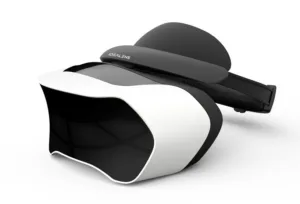At 19:00, May 5, 2016, the VR industry witnessed the official unveiling of its newest major product, the Idealens II in Seattle.
Along with the product release, Idealens made public the multiple key technologies employed by the device, and gained wide acclaim from the VR professionals who attended the event.
The World’s First All-in-one VR Headset with a Rear Battery Pack
The hardware components of the Idealens II, such as the modules for computing, display, tracking, and battery are all integrated into a compact body, so that the headset operates completely independently, without the need to connect to any kind of console or wires, thus eliminating the rigid limitations on the places for use by PC grade VR devices. But, the experience offered by the VR headset is comparable to that of the PC grade devices.
However, the advantage of portability of all-in-one headsets proposes rigorous requirements for wearing. Unlike other VR products, while bearing all hardware, all-in-one headsets need to meet the complex demands of mobility from the users, therefore there are greater requirements for wearable optimization, which is a very important technical issue. Idealens has presented an innovative solution in the II headset.
The all-in-one wearable solution of Idealens II has employed a rear battery pack for weight balance, the first of its category globally, allowing the weight of the helmet’s main body to be reduced to 320g for more balanced distribution of weight, therefore greatly reducing the burden on the neck.
With a mounting way featuring a steel structure with a spring mechanism, the wearing system of Idealens II fits comfortably on the head without the need of adjustment. Even when the user performs sudden physical movements, the device will not become loose.
Idealens II also provides some thoughtful features to the users, such as the multiple wearing modes, including game mode and cinema mode, allowing users to freely experience various application scenarios. Glasses wearers do not need to remove their glasses, or they may adjust the pupil distance to use the device directly, offering the most convenient wearable solution for the users in practical application situations.
Cutting-edge Updates of Optical Technologies for the VR FOV Comparable to the Human Eyes
For the rise of all-in-one VR headsets, the drive of hardware technology is the key. Currently, chip makers, such as Intel, Qualcomm and AMD all seek to optimize the flagship chips for VR devices. The application of AMOLED screens has provided substantial support for persistence control, while the key technical mission for VR manufactures is to provide good performance of optics, positioning and tracking, and wearability.
The first issue to be solved is the FOV (field of view) of VR devices. Currently, the mainstream products of the industry offer an FOV range between 96 and 110 degrees. But the FOV of Idealens II has reached to 120 degrees, which is the maximum value among various VR devices currently available on the market.
On this basis, Idealens II is supplied with two AMOLED screens, with a refresh rate of 90Hz, significantly reducing persistence for display. Thanks to the base algorithm developed by the Idealens team, the device is supplied with the advanced technologies of low lapse and the ATW (Asynchronous Time Warp), which can effectively reduce dizziness during use due to display delay. The overall delay can be controlled within 17ms and with top-speed response, users can experience a smoother, more realistic virtual world.
Idealens II will also launch a new position tracking accessory which is under international patent protection and of a lower cost and reaches a higher precision level of 1mm. The tracking accessory also supports the function of motion capture of multiple players which responds to movements in the virtual world and allows users to move, walk, jump and wield virtual weapons.
The release of Idealens II all-in-one VR headset not only welcomes a major product into the global VR line-up, but also enables the industry to truly enter the VR mobility era in terms of technology.
The features of the device, such as the 120-degree FOV, 17ms delay, precise and wide range position tracking, and comfortable and convenient wearing method, all enable the experience of the mobile VR device to reach or even exceed that of the PC-attached products, making it the new benchmark for the entire VR industry.

